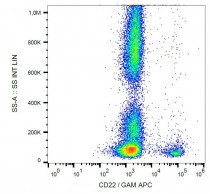ARG62773
anti-CD22 antibody [IS7]
anti-CD22 antibody [IS7] for Flow cytometry and Human
Cancer antibody; Developmental Biology antibody; Immune System antibody; Immature B Cell Marker antibody
Overview
| Product Description | Mouse Monoclonal antibody [IS7] recognizes CD22 |
|---|---|
| Tested Reactivity | Hu |
| Tested Application | FACS |
| Specificity | The clone IS7 reacts with CD22 (BL-CAM), a 130 kDa type I transmembrane glycoprotein (immunoglobulin superfamily) expressed in the cytoplasm of pro-B and pre-B lymphocytes, and on the surface of mature and activated B lymphocytes; it is lost on plasma cells, peripheral blood T lymphocytes, granulocytes and monocytes. HLDA IV; WS Code B 227 HLDA V; WS Code B CD22.8 |
| Host | Mouse |
| Clonality | Monoclonal |
| Clone | IS7 |
| Isotype | IgG1 |
| Target Name | CD22 |
| Antigen Species | Human |
| Immunogen | Reh human cell line |
| Conjugation | Un-conjugated |
| Alternate Names | B-lymphocyte cell adhesion molecule; B-cell receptor CD22; T-cell surface antigen Leu-14; BL-CAM; SIGLEC-2; Sialic acid-binding Ig-like lectin 2; Siglec-2; CD antigen CD22; SIGLEC2 |
Application Instructions
| Application Suggestion |
|
||||
|---|---|---|---|---|---|
| Application Note | FACS: Lyse, wash protocol. * The dilutions indicate recommended starting dilutions and the optimal dilutions or concentrations should be determined by the scientist. |
||||
| Positive Control | FACS: lysed whole blood |
Properties
| Form | Liquid |
|---|---|
| Purification | Purification with Protein A. |
| Purification Note | 0.2 µm filter sterilized. |
| Purity | > 95% (by SDS-PAGE) |
| Buffer | PBS (pH 7.4) |
| Concentration | 1 mg/ml |
| Storage Instruction | For continuous use, store undiluted antibody at 2-8°C for up to a week. For long-term storage, aliquot and store at -20°C or below. Storage in frost free freezers is not recommended. Avoid repeated freeze/thaw cycles. Suggest spin the vial prior to opening. The antibody solution should be gently mixed before use. |
| Note | For laboratory research only, not for drug, diagnostic or other use. |
Bioinformation
| Database Links | |
|---|---|
| Gene Symbol | CD22 |
| Gene Full Name | CD22 molecule |
| Background | CD22, also known as Siglec-2 (sialic acid-binding immunoglobulin-like lectin-2) is a transmembrane glycoprotein binding alpha2,6-linked sialic acid-bearing ligands. Intracellular domain of CD22 recruits protein tyrosine phosphatase SHP-1 through the immunoreceptor tyrosine-based inhibitory motifs (ITIMs), thus setting a treshold for B cell receptor-mediated activation. CD22 also regulates B-cell response by involvement in controlling the CD19/CD21-Src-family protein tyrosine kinase amplification pathway and CD40 signaling. CD22 exhibits hallmarks of clathrin-mediated endocytic pathway. |
| Function | Mediates B-cell B-cell interactions. May be involved in the localization of B-cells in lymphoid tissues. Binds sialylated glycoproteins; one of which is CD45. Preferentially binds to alpha-2,6-linked sialic acid. The sialic acid recognition site can be masked by cis interactions with sialic acids on the same cell surface. Upon ligand induced tyrosine phosphorylation in the immune response seems to be involved in regulation of B-cell antigen receptor signaling. Plays a role in positive regulation through interaction with Src family tyrosine kinases and may also act as an inhibitory receptor by recruiting cytoplasmic phosphatases via their SH2 domains that block signal transduction through dephosphorylation of signaling molecules. [UniProt] |
| Research Area | Cancer antibody; Developmental Biology antibody; Immune System antibody; Immature B Cell Marker antibody |
| Calculated MW | 95 kDa |
| PTM | Phosphorylation of Tyr-762, Tyr-807 and Tyr-822 are involved in binding to SYK, GRB2 and SYK, respectively. Phosphorylation of Tyr-842 is involved in binding to SYK, PLCG2 and PIK3R1/PIK3R2. Phosphorylated on tyrosine residues by LYN. |
Images (1) Click the Picture to Zoom In






